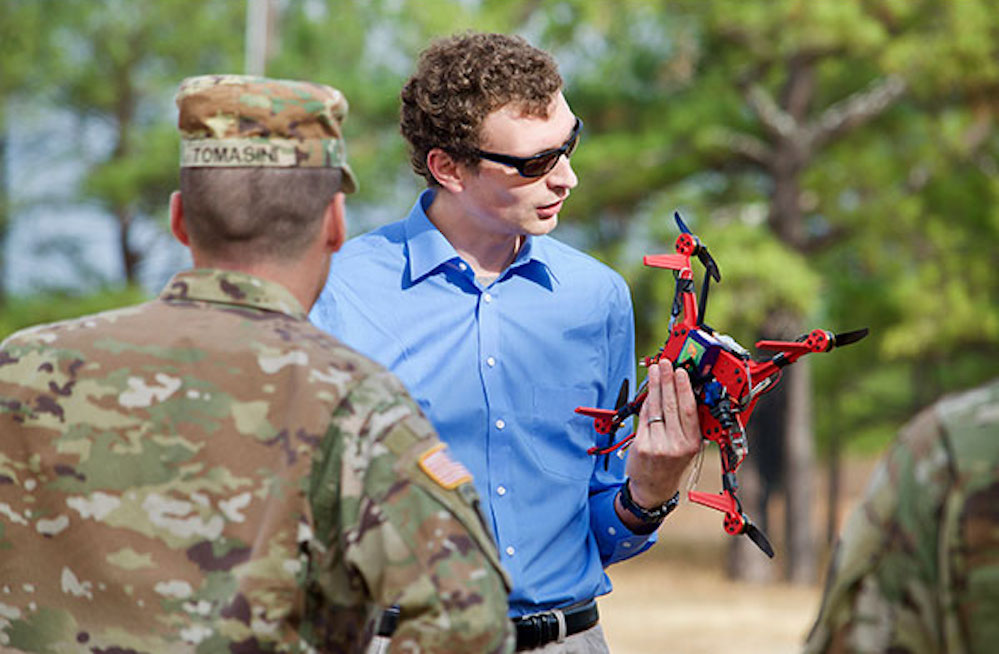
3D-printed drones are a point of fascination within the United States military.
The military has been testing 3D-printed drones that are in use for on-demand military missions, using technology called the On-Demand Small Unmanned Aircraft System (ODSUAS). Soldiers can input mission requirements into the system, with a 3D printer providing the optimal configuration, printed out and delivered within 24 hours for an unmanned aerial vehicle.
3D printing technology is already being used by the military to print specialized items. For example, researchers used ODSUAS to create a Picatinny rail, which is a bracket that mounts a small arms weapon. The process took under three hours, showing why the prompt and effective technology is one the military is using confidently.
The Marine Corps, in particular, have embraced drone technology. Marine Corps Commandant Gen. Robert Neller stated last year that, by the end of 2017, he hopes for every infantry squad to own a quadcopter. Neller and others in the Marine ranks have also been receptive to adding new assistant squad leader roles, specifically for flying UAVs and managing the 3D-printed information.
The Marine Corps has some reasons to embrace 3D-printed drones:
More Access to Information
Drone technology has existed in the military for some time, though they are often expensive. Military drones like the Raven cost around $250,000. 3D-printed drones, meanwhile, can cost as low as $1,000 for military use. The low price is one reason Neller expresses hope to have each infantry squad to be fitted with a quadcopter.
The quadcopter itself can be a great form of intelligence gathering. If each infantry squad has a 3D-printed drone with specific directions regarding their mission, the potential for efficiency increases. Drones can help survey the area and provide pinpoint accuracy regarding whereabouts, with the additional ability to communicate with HQ. These reasons make drones ideal for information gathering.
Prompt Effectiveness
The Marines hope to someday assemble a scout drone in a mere three minutes and have it airborne one minute later, with its route mapped out beforehand to eliminate risk. High-definition, real-time video from the drone’s feed is available to the Marines, who can use vital information captured in a low-risk manner for future mission planning.
Although that speed of crafting a drone and putting it in the air within five minutes is not yet feasible, future advancements in drone technology make it a strong possibility. Plus, drone technology is already among the most efficient methods for the military to visually track and record intelligence. As a result, for the present and future, the Marines value the promptness and effectiveness of drone technology during mission operations.
Familiarity With a Rising Technology
The Army has already been investigating anti-quadcopter defense, knowing full well that present and future foes are likely to have drones in their military arsenal. As a result, it makes sense for all branches of our military to explore how to use quadcopters on offense so they can anticipate similar tactics from their enemy. Drones very likely will play a large role in future military conflict, so familiarity with the technology seems prudent.
3D Printed Drones vs. Normal Drones
The Marines are opting for 3D-printed drones, primarily due to the time-sensitive nature of military operations. Drones made with 3D printers can undergo repairs quickly since the printing technology can produce replacement parts that mend most issues almost immediately. Compared to a typical drone, where expensive replacement parts must come from the manufacturer, 3D-printed drones hold more appeal.
Although both types of drones can provide camera-based functionality, the Marines value the time-sensitive appeal of 3D-printed drones, which provide added versatility and are generally at a lower price point than their non-3D-printed counterparts.
Featured Image Source: U.S. Army; Photo by Angie DePuydt

